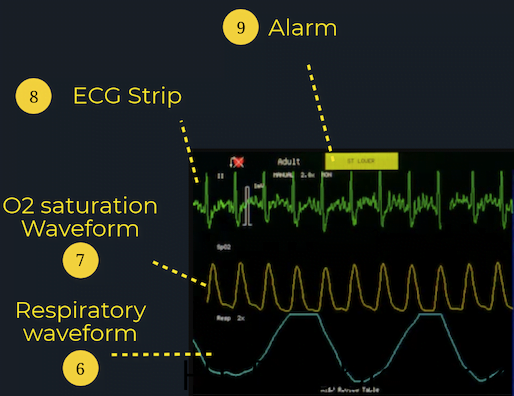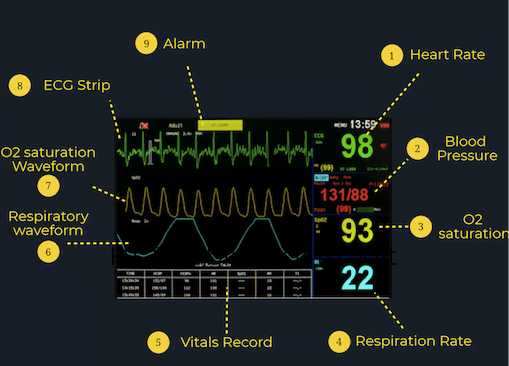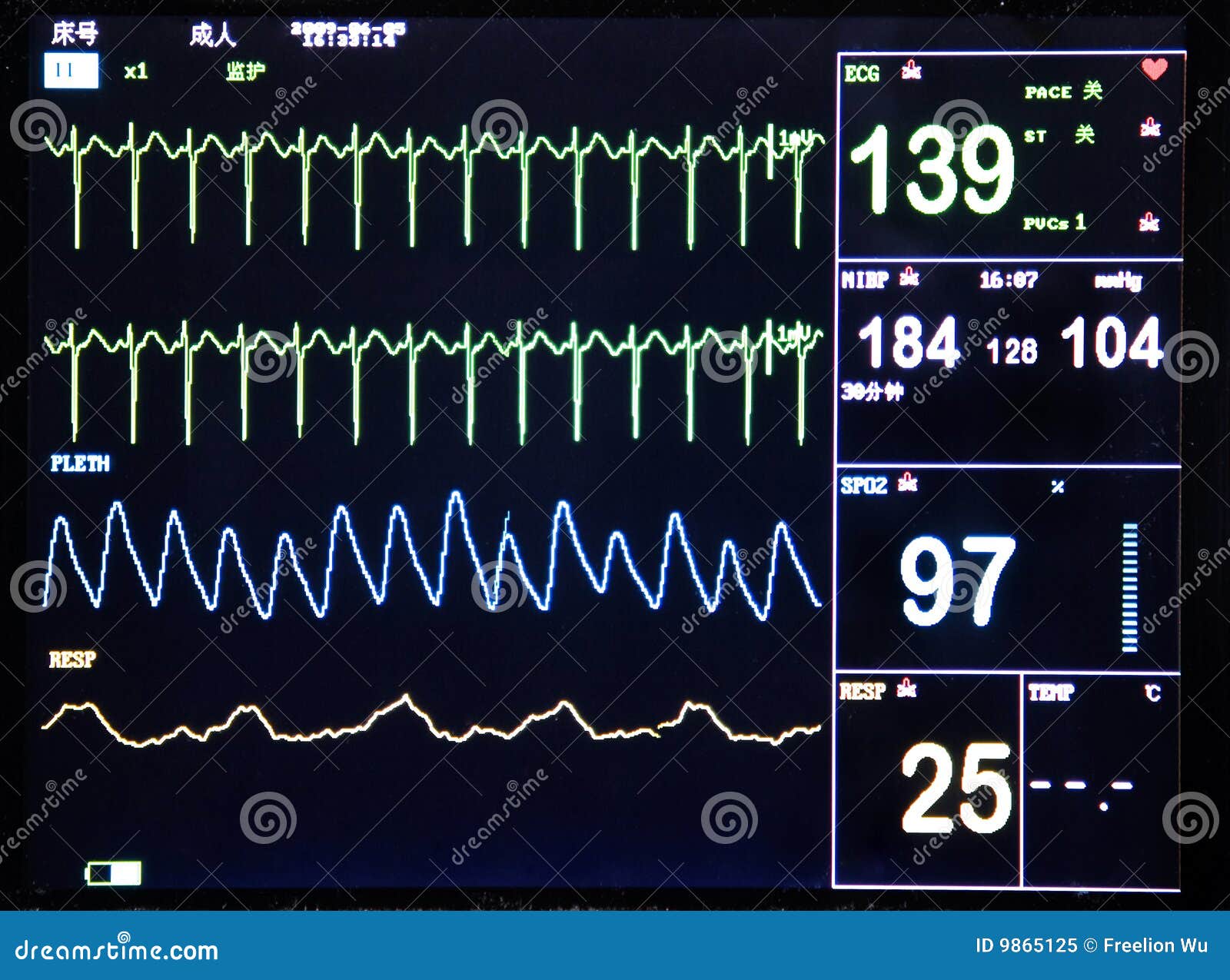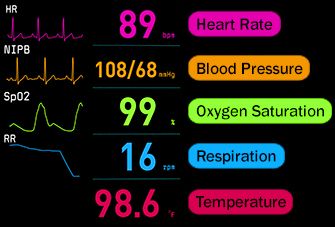How To Read A Heart Monitor
Reading the Numbers Heart Rate. How to Hear Your Own Heartbeat Without a Stethoscope.
 How To Read Patient Monitors Canadiem
How To Read Patient Monitors Canadiem
During your appointment stickers called electrodes will be put onto your chest to monitor your heart rate and rhythm.

How to read a heart monitor. It ends at the first rise or dip of the beat. The vertical lines on the paper cut the waves into five sections denoted with letters PQRST. Use the squares on the EKG results to measure your heartbeat 1.
Therefore the best reading is achieved when your hand is warm relaxed and below the level of your heart. Both are important for rhythm interpretation. This usually involves a beeping noise and a flashing color.
A good heart rate monitor or vital signs monitor should also measure your body temperature. But your doctor may want a prolonged more detailed reading. Another reading is marked with a heart symbol or PRbpm.
A technician will attach electrodes to a persons chest and the person will wear the monitor. This reading indicates heart or pulse rate. Interpreting Numbers on a Monitor.
These electrodes are attached by wires and detect every activity of the heart and transmit it to the monitor where it is recorded and displayed as a waveform on the screen. Determine Your Heart Rate. A Holter monitor is a medical device that can help to diagnose heart problems such as arrhythmias.
Reading a Fetal Monitor Can Help You Understand Your Labor This was a way to tell how your baby was coping with labor. You wear the Holter monitor for 12 to. Twenty-four hour Holter monitoring is a continuous test to record your hearts rate and rhythm for 24 hours.
Put the oximeter on your index middle or ring finger and make sure it fits well not too loose not too tight. When you keep the pulse oximeter on a fingertip the screen shows you 2 readings on it. P waves measure the depolarization of the atria which means a heart muscle contraction according to a July 2020 article in StatPearls.
This indicates your oxygen levels in your blood in percentage. Locate the Flat or Wavy Line Between the Peaks This is the P wave. Electronic fetal monitoring came onto the scene before being thoroughly tested for reliability but the premise behind it was that it would provide a graph to see how the babys heart rate responded in conjunction with a contraction.
In reading blood pressure information on your monitor always start with the systolic reading followed by the diastolic reading. Many will highlight the problem. The EKG and the Echo will give your cardiologist a reading of your hearts activity in that moment.
Your heart rate is. Understand that the squares that are bold are designated in measurements of one second and that they are made up of 25 squares. To get the most accurate reading allow 5 to 20 seconds for your pulse rate to stabilize and for the oximeter to detect your pulse.
Look for consistent time intervals between spikes which may indicate regular heart rhythm. P is the small hump before the dip Q is the tiny dip before the spike R is the spike S is the dip after the spike and T is the low spike after the dip. Basically this is a system that consists of wires with electrodes that stick to the babytwo on either side of the chest and one on the lower abdomen or on a leg.
These stickers are attached to the heart monitor. Follow the manufacturers instructions. One is for oxygen saturation and is marked usually as Spo2.
Some men may need to have a small area on their chest shaved in order for the electrodes to stick to the skin. Check heart functions by looking at the electrocardiogram ECG. Look at the EKG to see if the rate is regular and how fast the heart is beating.
If one of your vital signs rises or falls outside healthy levels the monitor will sound a warning. To get the best reading from your oximeter you must ensure that enough blood is flowing to your hand and finger wearing the device. Method 2 of 3.
A stable rhythm often correlates with a stable patient. Your pulse oximeter measures your oxygen saturation or the percentage of blood that carries oxygen. Reading Lines on a Patient Monitor.
How to Read a Hospital Monitor Method 1 of 3. Sometimes its easier to read printouts by looking at them sideways. When the machine prints out graph paper youll see the fetal heart rate to the left and the contractions to the right.
In the picture above we can read the home digital blood pressure monitor blood pressure measurements as 11878mmHg. The pace at which a rhythm is conducting can help determine the stability of the rhythm. Pulse reading can detect irregular heartbeat which is associated with cardiovascular problems.
A normal pulse rate for an adult is between 60 and 100 beats per. Of course the main thing which a heart rate monitor keeps track of is your heart rate. When youre looking at the screen the fetal heart rate is usually on the top and the contractions at the bottom.
How to read pulse oximeter.
Hollywood Medical Myths Part 1 Shocking Someone Who Has Flat Lined Can Get Their Heart Going Again
 How To Read Patient Monitors Canadiem
How To Read Patient Monitors Canadiem
 How To Read Patient Monitors Canadiem
How To Read Patient Monitors Canadiem
How To Read A Monitor In Icu Quora
Heart Heart Rate Monitor Hospital How To Read
How To Read Hospital Monitors Quora
 Heart Blood Pressure Monitor Used Stock Footage Video 100 Royalty Free 11126765 Shutterstock
Heart Blood Pressure Monitor Used Stock Footage Video 100 Royalty Free 11126765 Shutterstock
 3 Ways To Read A Hospital Monitor Wikihow
3 Ways To Read A Hospital Monitor Wikihow
 Monitoring Of Patients Condition Vital Stock Footage Video 100 Royalty Free 20286253 Shutterstock
Monitoring Of Patients Condition Vital Stock Footage Video 100 Royalty Free 20286253 Shutterstock
 16 825 Monitor Heart Photos Free Royalty Free Stock Photos From Dreamstime
16 825 Monitor Heart Photos Free Royalty Free Stock Photos From Dreamstime
 Normal Heart Monitor Reading Page 1 Line 17qq Com
Normal Heart Monitor Reading Page 1 Line 17qq Com
 Cardiovascular Services In Prince William Prince William Living
Cardiovascular Services In Prince William Prince William Living
 How To Read A Vital Signs Monitor
How To Read A Vital Signs Monitor
Comments
Post a Comment